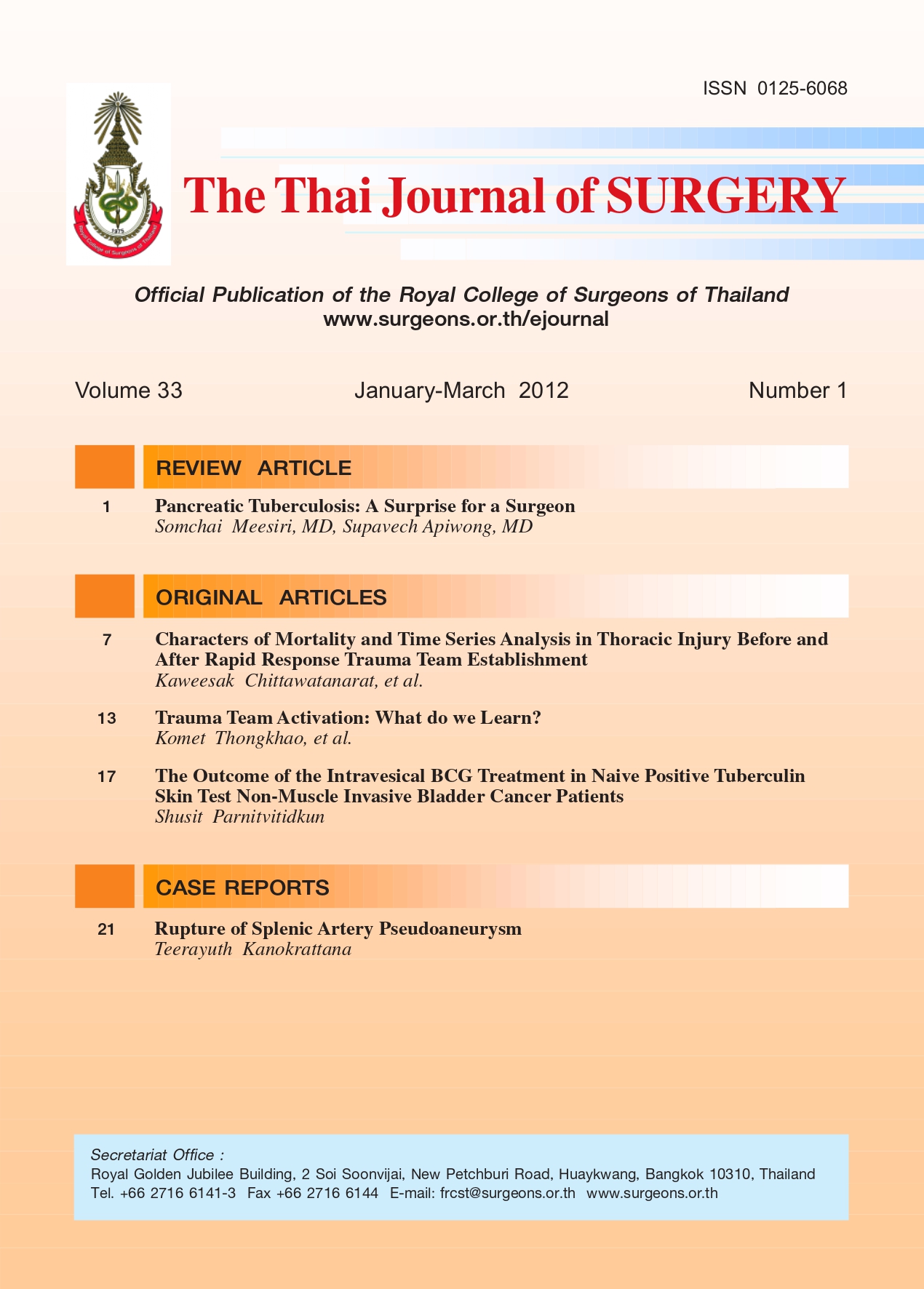Characters of Mortality and Time Series Analysis in Thoracic Injury Before and After Rapid Response Trauma Team Establishment
Keywords:
Maxillofacial injury, Mortality, Multiple injuries, Rapid response trauma team, Time series analysis, Thoracic injuryAbstract
Background: Severe thoracic injury is a life threatening condition and needs prompt as well as proper treatment. The Department of Surgery, Faculty of Medicine, Chiang Mai University has established the Rapid Response Trauma Team (RRTT) in July 2006. The aim of this study was to verify mortality rate alteration after setting up the RRTT.
Methods: We performed a retrospective “before and after” designed study between January 2004 and September 2009. The month before July 2006 was defined as “before RRTT” and after was “after RRTT”. Monthly mortality rate, severity injury score (ISS) and demographic data were collected.
Results: A total of 951 patients were included [427 (30 months) in before RRTT and 524 (39 months) in after RRTT]. Of these, 83 patients (8.8%) died after admission and were analyzed for characteristics of mortality. The average age of mortality cases was 38.7 ± 16.3 years. Male was a predominant gender. The most common mechanism of injury was motor cycle accident. Although there were no difference of characters and mechanisms of injuries between two periods but patients associated with maxillofacial injury had significant lower mortality in after RRTT (28.5% vs. 10.5%; p = 0.04). The after RRTT group had a significantly higher occurrence of urinary complication and acute renal failure. The average adjusted monthly mortality rate was lower in after RRTT (9.0 ± 6.1 vs. 6.9 ± 4.0%). Time series analysis between two periods demonstrated a trend towards decrease in monthly mortality after RRTT [coefficient(95% CI) = -0.61(-1.13 to -0.23); p<0.01)].
Conclusion: The RRTT establishment could decrease mortality rate. The protective effect was predominant in patients associated with maxillofacial injuries.
References
2. Church AL, Plitponkarnpim A. Emergency medicine in Thailand. Ann Emerg Med 1998;32:93-7.
3. Sikand M, Williams K, White C, Moran CG. The financial cost of treating polytrauma: implications for tertiary referral centres in the United Kingdom. Injury 2005;36:733-7.
4. Demetriades D, Martin M, Salim A, et al. Relationship between American College of Surgeons trauma center designation and mortality in patients with severe trauma (injury severity score > 15). J Am Coll Surg 2006;202:212-5; quiz A45.
5. Demetriades D, Berne TV, Belzberg H, et al. The impact of a dedicated trauma program on outcome in severely injured patients. Arch Surg 1995;130:216-20.
6. Burnham KP, Anderson DR. Multimodel inference: Understanding AIC and BIC in model selection. Sociological methods and research, 2004;33:261-304.
7. Shittu OI, Asemota MJ. Comparison of criteria for estimating the order of autoregressive process: A Monte Carlo approach. Eur J Sci Res 2009;30:409-16.
8. Cheung YW, Lai KS. Lag order and critical values of the augmentded Dickey-Fuller test. J Bus Eco Stat 1995;13:272- 80.
9. Sleigh AC, Seubsman SA, Bain C. Cohort profile: The Thai Cohort of 87,134 Open University students. Int J Epidemiol 2008;37:266-72.
10. Murray CJ, Lopez AD. Mortality by cause for eight regions of the world: Global Burden of Disease Study. Lancet 1997; 349:1269-76.
11. Cherry RA, King TS, Carney DE, Bryant P, Cooney RN. Trauma team activation and the impact on mortality. J Trauma 2007;63:326-30.
Downloads
Published
How to Cite
Issue
Section
License
Articles must be contributed solely to The Thai Journal of Surgery and when published become the property of the Royal College of Surgeons of Thailand. The Royal College of Surgeons of Thailand reserves copyright on all published materials and such materials may not be reproduced in any form without the written permission.


